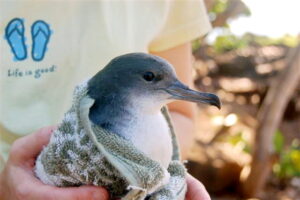
“Thanks for the lift. I’m going to Feather and Fur Veterinary Hospital for a little R and R.”
November 21, 2023
Say the word fallout and most people think of radioactive dust in the air from an atomic bomb blast or nuclear power plant failure. Because it falls from the sky, the dust is called fallout.
Hawaii’s fallout, however, has feathers. And we even have a season for it, easy to remember because it’s in the fall: October, November, and December.
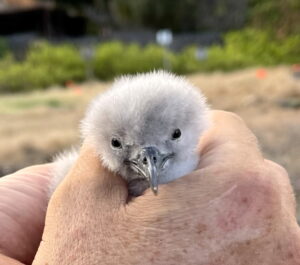
Hawaiʻi’s shearwaters and petrels nest on the ground in spring. This wedge-tailed shearwater chick, being weighed and measured by seabird researcher, David Hyrenbach, hatched at the Hawaiʻi Audubon Society’s seabird preserve on Oahu in mid-August. ©Susan Scott
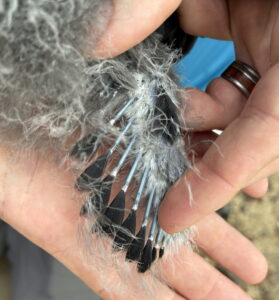
By September, chicks are growing in their flight feathers. Here, David shows me and several students the waxy covering still on the developing feather shafts. ©Susan Scott
During these autumn months, the summer’s shearwater and petrel chicks (Hawaii has 8 species, all protected by state and federal laws) take their first flights from their ground nests to the sea, using moonlight and starlight reflecting on the ocean’s surface as their beacon. Electric lights, however, confuse some of these youngsters, and they fly the wrong way. Once on land, the lost birds get exhausted, crash into human structures, and fall from the sky.
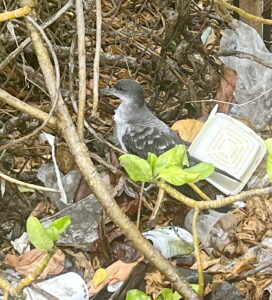
This downed youngster, found near Sea Life Park, joined hundreds of others at rescue center, Feather and Fur Veterinary Hospital in Kailua. We can also help our native birds by joining beach clean-ups. © David Hyrenbach.
Cars often hit and kill the birds that land on highways, but when a chick ends up on a lawn, a driveway, or in a bush, they’re often stunned and tired, and don’t know what to do next.
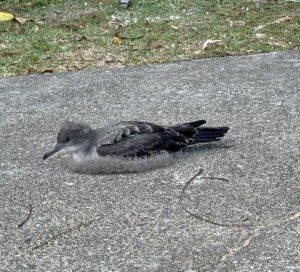
A friend called to ask what to do with this downy bird she found in her driveway on November 13th in Kailua’s Ola Mana neighborhood. She thought the bird fell from a tree but knows now that these seabirds are ground nesters, and that this youngster got lost on its maiden flight. I took it to shearwater rescue center, Feather and Fur Veterinary Hospital in Kailua. ©Susan Scott
These are the times when people can, and do, save hundreds of bewildered young seabirds. Thanks to the compassion and work of countless Hawaii residents, visitors, and wildlife professionals throughout the state, hundreds of our native birds are rescued and relaunched.
If you find such a bird please watch this short, charming video to learn what to do.
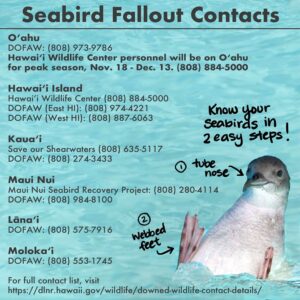
Shearwaters and petrels have tubelike nostrils on the top of their bill. Having a good sense of smell helps these seabirds find food in the open ocean.
To most of the world, fallout means deadly radiation. To us in Hawaii, though, fallout season means having the opportunity to save hundreds of our remarkable native seabirds.
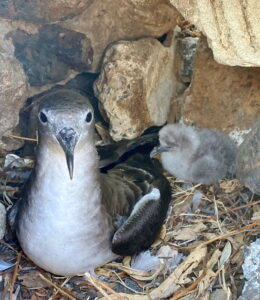
An Oahu wedge-tailed shearwater parent in its rocky burrow with its brand new baby, hatched August 2, 2023 ©Alyssa Piauwasdy
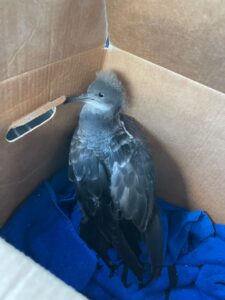
Thanks for the lift. This wedge-tailed shearwater rode in the passenger seat of my car on the way to Feather and Fur Veterinary Hospital, November 13, 2023. ©Susan Scott
Here in Hawaii, life is different from life in the rest of the world. For the privilege of living here and being able to associate lovely, living faces, both human and wild, with the word fallout, I am eternally thankful. Happy Thanksgiving.
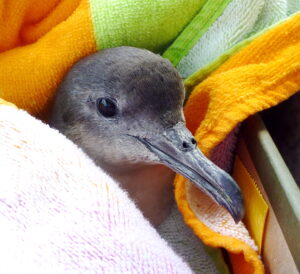
Hawaiʻi’s wedgie network: A kayaker, who donated her colorful beach towel to the rescue effort, found this downed bird on the beach at Kailua Beach Park. She called a friend, who called a seabird biologist who called me. Rescue accomplished. ©Susan Scott